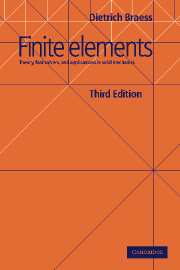Crossref Citations
This Book has been
cited by the following publications. This list is generated based on data provided by Crossref.
Braess, Dietrich
Hoppe, Ronald H. W.
and
Schöberl, Joachim
2008.
A posteriori estimators for obstacle problems by the hypercircle method.
Computing and Visualization in Science,
Vol. 11,
Issue. 4-6,
p.
351.
Wei Gao
Lixi Wan
and
Jun Li
2008.
A lowpass filter with an embedded capacitor for wideband noise suppression in Multi-GHz PCBs.
p.
1.
Griesbaum, Anke
Kaltenbacher, Barbara
and
Vexler, Boris
2008.
Efficient computation of the Tikhonov regularization parameter by goal-oriented adaptive discretization.
Inverse Problems,
Vol. 24,
Issue. 2,
p.
025025.
Vermolen, F. J.
Andreykiv, A.
van Aken, E. M.
Linden, J. C. van der
Javierre, E.
and
van Keulen, A.
2009.
Advanced Computational Methods in Science and Engineering.
Vol. 71,
Issue. ,
p.
289.
Benedix, Olaf
and
Vexler, Boris
2009.
A posteriori error estimation and adaptivity for elliptic optimal control problems with state constraints.
Computational Optimization and Applications,
Vol. 44,
Issue. 1,
p.
3.
Braess, Dietrich
2009.
An a posteriori error estimate and a comparison theorem for the nonconforming P 1 element.
Calcolo,
Vol. 46,
Issue. 2,
p.
149.
Aschwanden, A.
and
Blatter, H.
2009.
Mathematical modeling and numerical simulation of polythermal glaciers.
Journal of Geophysical Research: Earth Surface,
Vol. 114,
Issue. F1,
Horenko, Illia
2009.
On Robust Estimation of Low-Frequency Variability Trends in Discrete Markovian Sequences of Atmospheric Circulation Patterns.
Journal of the Atmospheric Sciences,
Vol. 66,
Issue. 7,
p.
2059.
Bostan, Viorel
and
Han, Weimin
2009.
Advances in Applied Mathematics and Global Optimization.
Vol. 17,
Issue. ,
p.
25.
Vermolen, F. J.
2009.
Simplified Finite-Element Model for Tissue Regeneration with Angiogenesis.
Journal of Engineering Mechanics,
Vol. 135,
Issue. 5,
p.
450.
Bonito, Andrea
Nochetto, Ricardo H.
Quah, John
and
Margetis, Dionisios
2009.
Self-organization of decaying surface corrugations: A numerical study.
Physical Review E,
Vol. 79,
Issue. 5,
Liu, G. R.
Xu, X.
Zhang, G. Y.
and
Gu, Y. T.
2009.
An extended Galerkin weak form and a point interpolation method with continuous strain field and superconvergence using triangular mesh.
Computational Mechanics,
Vol. 43,
Issue. 5,
p.
651.
Korobkin, Oleg
Aksoylu, Burak
Holst, Michael
Pazos, Enrique
and
Tiglio, Manuel
2009.
Solving the Einstein constraint equations on multi-block triangulations using finite element methods.
Classical and Quantum Gravity,
Vol. 26,
Issue. 14,
p.
145007.
ROGNES, MARIE E.
and
WINTHER, RAGNAR
2010.
MIXED FINITE ELEMENT METHODS FOR LINEAR VISCOELASTICITY USING WEAK SYMMETRY.
Mathematical Models and Methods in Applied Sciences,
Vol. 20,
Issue. 06,
p.
955.
Nagler, Loris
and
Schanz, Martin
2010.
An extendable poroelastic plate formulation in dynamics.
Archive of Applied Mechanics,
Vol. 80,
Issue. 10,
p.
1177.
Rauber, Thomas
and
Rünger, Gudula
2010.
Parallel Programming.
p.
359.
Kröner, Axel
Kunisch, Karl
and
Vexler, Boris
2010.
Recent Advances in Optimization and its Applications in Engineering.
p.
389.
Wang, Wenqing
and
Kolditz, Olaf
2010.
High Performance Computing and Applications.
Vol. 5938,
Issue. ,
p.
418.
Schmidt, Kersten
and
Tordeux, Sébastien
2010.
Asymptotic modelling of conductive thin sheets.
Zeitschrift für angewandte Mathematik und Physik,
Vol. 61,
Issue. 4,
p.
603.
Olshanskii, Maxim A.
and
Reusken, Arnold
2010.
A finite element method for surface PDEs: matrix properties.
Numerische Mathematik,
Vol. 114,
Issue. 3,
p.
491.





